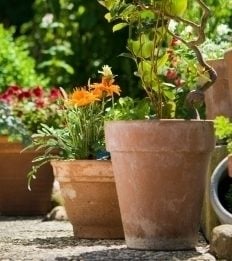Picking the Right Shape for Your Plant Pot
Plant and flower pots are wonderful landscaping ideas for your entrance way or backyard. A front door might call for a hanging basket to provide colour and fragrance at eye level, while a patio offers space for a variety of containers.

If your starting point is a plant, rather than a location, choose your pot accordingly: for example, a hydrangea will need a much larger pot than a geranium. If your outdoor space is limited, you may want to plant up one large container, but in a larger location you can combine several pots of varying size and shape to achieve the same effect as a border.
A Look to Suit the Plant
A large pot, because it holds more compost, is ideal for growing an interesting combination of plants. Once planted up, however, it will be difficult to move. To lighten the load, fill the base of large pots with polystyrene beads or bits of broken polystyrene plant trays. Another advantage to using a large container is that the compost is less likely to freeze around the roots in winter as it would in a smaller pot, and it won’t dry out so fast in summer.
You need to keep in mind the height of the mature planting when choosing a pot. A dwarf or low-growing plant can look swamped in a heavy container, while a large shrub will look badly proportioned in a narrow pot.
Stability is crucial if you are growing a tall plant, which might sway in the wind and eventually topple the pot. Containers with very tapered bases are particularly vulnerable. The most stable shapes are regular ones such as square pots, taller containers with wide shoulders, or large, round dishes.
To anchor a pot in place, drive a stake into the ground, or into the space between two paving slabs, place the drainage hole of the pot over the stake then slide the empty pot over it.
For a successful display, you need to consider the form and size of the plants you are choosing, the location, and the size and shape of your pot. Tall pots suit trailing plants such as ivy, creeping Jenny and ground ivy, which will hang over the pot edge in soft trails. Such pots are also ideal for growing lilies or clematis, which both need a deep, cool root run. Shallow containers such as old sinks and alpine dishes are more suited to the delicate shapes of rockery plants, spring bulbs such as crocus, and low-growing herbs.
Tall and elegant, narrow-necked pots, sometimes called Ali Baba jars, make a curvaceous focus on a patio or if set among plants in the garden. These ornamental pots are great backyard landscaping ideas and can look spectacular when filled with trailing stems, wispy grasses, or weeping plants, which create a cascade of foliage, like flowing water. However, the narrow necks of these pots make it almost impossible to remove a plant that needs repotting. Big-bellied pots present the same problem, but both can be used as cachepots, to disguise a plain plastic pot either set in the neck or placed inside the container. This is helpful if the plant needs to be lifted to a frost-free shelter in winter.
Square containers such as wooden Versailles boxes are also often used as cachepots. Their regular shapes set off topiary shrubs and trees that have been pruned into formal shapes.
Sleek and sculptural, simple and functional, or softly curved and glazed: a really beautiful pot will enhance any garden



